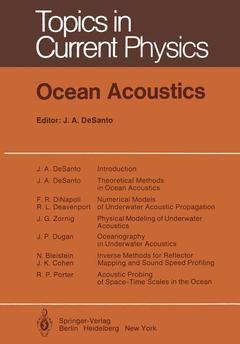Description
Ocean Acoustics, Softcover reprint of the original 1st ed. 1979
Topics in Current Physics Series, Vol. 8
Coordinator: DeSanto J.A.
Language: English
Subjects for Ocean Acoustics:
Keywords
Meer; Ocean; Schallausbreitung; Wasserschall; acoustics; hydrogeology
Ocean Acoustics
Publication date: 03-1979
Publication date: 03-1979
Ocean Acoustics
Publication date: 12-2011
288 p. · 17x24.4 cm · Paperback
Publication date: 12-2011
288 p. · 17x24.4 cm · Paperback
Description
/li>Contents
/li>
This Topics volume is devoted to a study of sound propagation in the ocean. The effect of the interior of the ocean on underwater sound is analogous to the effect of a lens on light. The oceanic lens is related, as in light propagation, to the index of refraction of the medium. The latter is giv~n by the ratio of the sound frequency to the speed of sound in water, typi ca lly about 1500 m s -1. It is the vari ation of the sound speed due to changing temperature, density, salinity, and pres sure in the complex ocean environment which creates the lens effect. Many oceanic processes such as currents, tides, eddies (circulating, translating regions of wa ter), and internal waves (the wave-like structure of the oceanic density variabil ity) contri bute in turn to the changes in sound speed'. The net effect of the ocean lens is to trap and guide sound waves in a channel created by the lens. The trapped sound can then propagate thousands of miles in this oceanic waveguide. In addition to the propagation in the interior of the ocean, sound can propagate into and back out of the ocean bottom as well as scatter from the ocean surface. Just as the sound produced by a loudspeaker in a room is affected by the walls of the room, so the ocean boundaries and the material properties below the ocean bottom are essential ingredients in the problem.
1. Introduction.- 1.1 A Brief History.- 1.2 Outline of the Book.- References.- 2. Theoretical Methods in Ocean Acoustics.- 2.1 Conservation Laws, Fluid and Acoustic Equations.- 2.1.1 Conservation Laws and Fluid Equations.- 2.1.2 A Parabolic Equation.- 2.1.3 Perturbation Method.- 2.1.4 Combined Acoustic-Internal Wave Equations.- 2.1.5 Sound Speed.- 2.2 Propagation in Deterministic Media.- 2.2.1 One-Dimensional Problems.- a) The Pekeris Waveguide.- b) Alternative Representations.- c) Solvable Profiles.- d) Inverse Propagation.- 2.2.2 Two-Dimensional Problems.- a) Ray-Theory.- b) Corrected Parabolic Approximation.- c) Conformal Mapping.- 2.2.3 Multi-Dimensional Problems.- 2.3 Wave Propagation in a Random Medium.- 2.3.1 The Hierarchy Problem.- 2.3.2 Coherent Waves.- 2.3.3 Coherence Function and Related Work.- 2.3.4 Propagation of the Coherence Function in a Waveguide.- 2.4 Scattering from Rough Surfaces.- 2.4.1 The Rayleigh Hypothesis.- 2.4.2 Periodic Surfaces.- a) Rectangular Periodic Surfaces.- b) The Sinusoidal Surface.- 2.4.3. Arbitrary Deterministic Surfaces.- a) Green’s Function Formalism.- b) Diagrams.- 2.4.4 Random Surfaces.- a) Gaussian Surfaces.- b) Dyson Equation.- c) Coherent Specular Intensity.- d) Remarks.- References.- 3. Numerical Models of Underwater Acoustic Propagation.- 3.1 Range-Independent Models.- 3.1.1 Depth-Dependent Green’s Function (Impedance Formulation).- a) Matrizant Method.- 3.1.2 Direct Numerical Integration: Fast Field Program (FFP).- 3.1.3 Normal Mode (and Branch Line Integral) Models.- a) Stickler (EJP Cuts), Bartberger (Pekeris Cuts).- b) Stickler’s Residue Contribution.- c) Bartberger’s Residue Contribution (Pekeris Cuts).- d) Branch Cuts, and Branch Cut Integrals.- e) Numerical Considerations.- 3.1.4 Depth Dependent Green’s Function (Traveling-Wave Formulation).- 3.1.5 Multipath Expansion Models.- 3.1.6 Connection Between Modes and Rays.- 3.1.7 Quantitative Model Assessment.- 3.1.8 Waveform Prediction Models.- 3.2 Range-Dependent Models.- 3.2.1 Split Step Algorithm for Parabolic Equation.- 3.2.2 Parabolic Decomposition Method.- 3.2.3 Finite Differences.- 3.2.4 Range-Dependent Normal Mode Theory.- 3.2.5 Range-Dependent Ray Theory Models.- 3.2.6 Finite Element Approach.- a) The Finite Element Method.- b) Merits/Shortcomings of the FEM.- c) Transparent Boundary Simulation Techniques.- d) Solid Domain Boundaries.- e) Fluid Domain Boundaries.- f) Combined Solid-Fluid Domain Boundaries.- g) Fluid Finite Elements.- References.- 4. Physical Modeling of Underwater Acoustics.- 4.1 Background Information.- 4.1.1 Definition and Purpose.- 4.1.2 Relationship to Ocean Experimentation.- 4.1.3 Historical Overview.- 4.2 Water Facilities.- 4.2.1 Model Tanks.- 4.2.2 Lakes and Bays.- 4.3 Targets.- 4.3.1 Wind Driven Surfaces.- 4.3.2 Fixed Surfaces.- 4.3.3 Volume Targets.- 4.4 Instrumentation and Signal Processing.- 4.4.1 Sources.- 4.4.2 Data Acquisition.- 4.4.3 Signal Processing.- 4.5 Results of Physical Model Experimentation.- 4.5.1 Scattered Intensity.- 4.5.2 Coherence Studies.- 4.5.3 Second-Order Coherence.- 4.5.4 Frequency Spreading.- 4.6 Remarks.- References.- 5. Oceanography in Underwater Acoustics.- 5.1 Properties of Seawater.- 5.2 Ocean Variability.- 5.2.1 Ocean Climatology.- 5.2.2 Ocean Weather.- 5.2.3 Internal Waves.- 5.2.4 Fine Structure.- 5.2.5 Near-Surface Structure.- References.- 6. Inverse Methods for Reflector Mapping and Sound Speed Profiling.- 6.1 The POFFIS Identity.- 6.1.1 Derivation of the POFFIS Identity.- 6.1.2 The Limited Aperture Problem for the POFFIS Identity.- 6.2 An Inverse Method for Determining Small Inhomogeneities in a Medium.- 6.2.1 An Integral Equation for Three-Dimensional Velocity Variation.- 6.2.2 Direct Inversion for Backscatter over a Medium with Two-Dimensional Velocity Variation.- 6.2.3 Direct Inversion for a Case with Separated Source and Receiver.- 6.2.4 Direct Inversion for a One-Dimensional Problem.- 6.2.5 Direct Inversion in Free Space.- References.- 7. Acoustic Probing of Space-Time Scales in the Ocean.- 7.1 Sound Probes of Ocean Currents.- 7.1.1 SOFAR Floats for Lagrangian Current Measurements.- 7.1.2 Current Measurements by Reciprocal Transmissions.- 7.2 Acoustic Fluctuations as a Measure of Ocean Dynamics.- 7.2.1 CW Transmissions and Tides.- 7.2.2 Short Pulse Transmissions Along Single Paths.- 7.2.3 Spatial and Temporal Fluctuations of CW Transmissions.- 7.2.4 Spectra of Phase and Amplitude Fluctuations.- 7.3 Sound Speed Variations and Internal Gravity Waves.- 7.3.1 Internal Gravity Wave Spectra.- 7.3.2 Fluctuations in the Index of Refraction.- 7.4 Acoustic Fluctuation Theories and Their Relationship to Ocean Dynamics.- 7.4.1 Acoustic Fluctuation Theories and Their Relationship to Ocean Dynamics.- 7.4.2 Effect of Large Scale Flows on Acoustic Amplitude and Phase.- 7.4.3 Effect of Internal Waves on Acoustic Amplitudes and Phases.- 7.4.4 Multipath Fluctuations for Stable Paths.- 7.4.5 Stability of Single Paths.- 7.5 Implications for Ocean Probing.- References.
© 2024 LAVOISIER S.A.S.
These books may interest you

Ocean Acoustics 137.14 €



